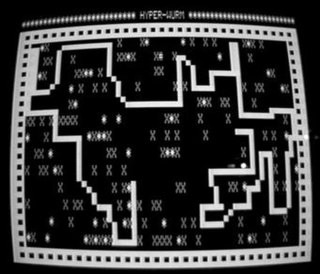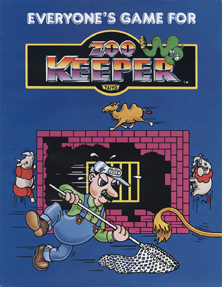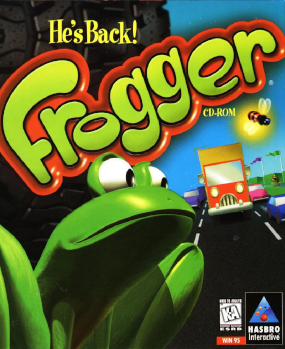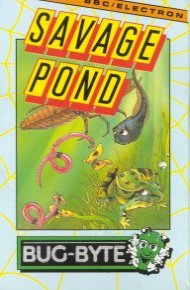
Millipede is a fixed shooter video game released in arcades by Atari, Inc. in 1982. The sequel to 1981's Centipede, it has more gameplay variety and a wider array of insects than the original. The objective is to score as many points as possible by destroying all segments of the millipede as it moves toward the bottom of the screen, as well as eliminating or avoiding other enemies. The game is played with a trackball and a single fire button which can be held down for rapid-fire.

Snake is a genre of action video games where the player maneuvers the end of a growing line, often themed as a snake.

Frogger is a 1981 arcade action game developed by Konami and published by Sega. In North America, it was distributed by Sega/Gremlin. The object of the game is to direct five frogs to their homes by dodging traffic on a busy road, then crossing a river by jumping on floating logs and alligators.

Mouse Trap is a maze video game developed by Exidy and released in arcades in 1981. It is similar to Pac-Man, with the main character replaced by a mouse, the dots with cheese, the ghosts with cats, and the energizers with bones. After collecting a bone, pressing a button turns the mouse into a dog for a brief period of time. Color-coded doors in the maze can be toggled by pressing a button of the same color. A hawk periodically flies across the maze, unrestricted by walls.

Pooyan (プーヤン) is a fixed shooter arcade video game released by Konami in Japan in 1982. It was manufactured in North America by Stern Electronics. The player controls "Mama", a pig whose babies have been kidnapped by a group of wolves.

K.C. Munchkin!, released in Europe as Munchkin, is a maze game for the Magnavox Odyssey 2. Its North American title is an inside reference to then president of Philips Consumer Electronics, Kenneth C. Menkin.

Food Fight is an arcade video game developed by General Computer Corporation and released by Atari, Inc. in March 1983. The player guides Charley Chuck, who is trying to eat an ice cream cone before it melts, while avoiding four chefs bent on stopping him. 1,951 arcade cabinets were sold.

The common frog or grass frog, also known as the European common frog, European common brown frog, European grass frog, European Holarctic true frog, European pond frog or European brown frog, is a semi-aquatic amphibian of the family Ranidae, found throughout much of Europe as far north as Scandinavia and as far east as the Urals, except for most of the Iberian Peninsula, southern Italy, and the southern Balkans. The farthest west it can be found is Ireland. It is also found in Asia, and eastward to Japan. The nominative, and most common, subspecies Rana temporaria temporaria is a largely terrestrial frog native to Europe. It is distributed throughout northern Europe and can be found in Ireland, the Isle of Lewis and as far east as Japan.

Super Pac-Man is a 1982 maze chase arcade game developed and published by Namco. It was distributed in North America by Midway, and is Namco's take on a sequel to the original Pac-Man; Midway had previously released Ms. Pac-Man, which Namco had little involvement with. Toru Iwatani returns as designer.

Rampage is a 1986 arcade video game by Bally Midway. Inspired by monster films, players control a trio of monsters: George, Lizzie, and Ralph, humans turned into creatures due to various experimental mishaps. The objective is to destroy cities and combat military forces while maintaining their health. The game is set across 128 days in cities across North America, with each cycle repeating five times. Gameplay includes destroying buildings, eating humans, and avoiding damage.

Frostbite is a 1983 action game designed by Steve Cartwright for the Atari 2600, and published by Activision in 1983. The game has a player control Frostbite Bailey, who must hop across several ice floes to collect ice while avoiding falling in the water and avoiding the hazardous natural elements such polar bears and snow geese.

Zoo Keeper is an arcade video game created by Taito America and released in 1983. The player controls Zeke, a zookeeper, attempting to rescue his girlfriend Zelda from a zoo where the animals have escaped from their cages. The majority of the game takes place on a screen where the player builds a wall to keep animals in the zoo – jumping escaped animals to avoid contact. Two different platform game levels are interspersed every few rounds. Zoo Keeper was sold as a conversion kit for Taito's Qix.
Blaster is a first-person rail shooter released as an arcade video game by Williams Electronics in 1983. It was developed by Eugene Jarvis and Larry DeMar. A vague sequel to Robotron: 2084, the game is a shoot 'em up set in outer space. The goal is to destroy enemies, avoid obstacles, and rescue astronauts in twenty levels, to reach paradise.

The squirrel tree frog is a small species of tree frog found in the south-eastern United States, from Texas to Virginia. This is an introduced species in the Bahamas. Squirrel tree frogs are small frogs, about 1.5 inches in length as adults. There are several color variations, but most commonly they are green and look very much like the American green tree frog. They can also be varying shades of yellow or brown, sometimes with white or brown blotching.

Frogger, also called Frogger: He's Back!, is a 1997 action game developed by SCE Studio Cambridge and published by Hasbro Interactive. It is a remake and expansion of Konami's 1981 arcade game of the same name. It has large maps, 3D graphics, and new gameplay moves. Critical reaction was mixed, with frequent criticism of the gameplay, controls, and difficulty, but the graphics were received positively. It was a commercial success, becoming one of the best-selling PlayStation games.

Anteater is an arcade video game designed by Chris Oberth and released in 1982 by Tago Electronics. The player steers the tongue of the eponymous creature through a maze, retracting it when dangers approach. Though the arcade game was not a hit, it spawned a number of direct clones for home computers; Sierra's Oils Well became better known than the original. Oberth wrote an Apple II version of his own game for Datamost using a different title.

Frogs is a single-player action arcade game released by Gremlin in 1978. It notably featured a jumping character. The game's graphics are "projected" by laying the monitor flat on its back and reflecting the computer-generated graphics of the frogs and flies toward the player via a mirror at a 45-degree angle. The game was distributed by Sega in Japan.

Hydra is a 1990 arcade vehicular combat video game developed and published by Atari Games. In Hydra, the player pilots a hovercraft, trying to deliver top secret items while avoiding mines, other hovercraft, and logs. The player can collect money and fuel to continue. X-Y yoke control.

Kissin' Kousins is an action game published in 1985 for the Acorn Electron, Atari 8-bit computer, and BBC Micro by English Software.





















